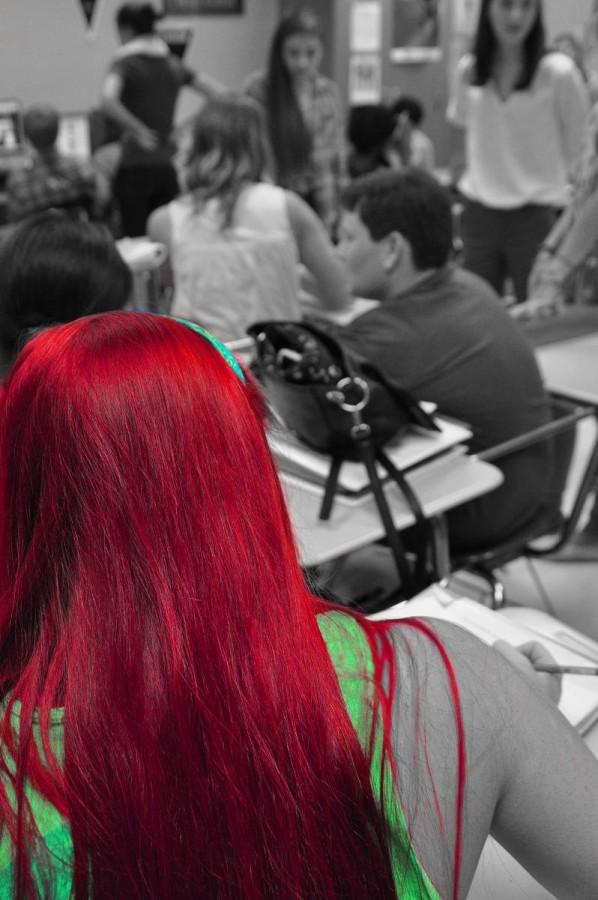Redefinition of distracting hair grants students more expressive freedom
Photo Credit: Beryl Kessio Noah Lombard
August 15, 2014
Every year when the schools doors open, students inevitably arrive with the shades of summer in their hair. Pink, purple, blue and other unnatural colors have become extremely popular hues to dye one’s hair. Unfortunately in years past, there has been a vague understanding of what is accepted under the school’s policy and what is not. Assistant principal Tandy Shumate, who presides over student discipline, aided principal Mike Campbell in redefining what is distracting to today’s students in a learning environment.
“In years past, unnatural hair color was deemed the color you were not born with such a as pink, blue, green. Mr.Campbell and I discussed this at length [and] we determined a child [with colored hair] passing in the hallway is not a distraction. We will only handle it as administrators if it disrupts the learning environment,” Shumate said.
The 2014-2015 Madison County Schools Student Code of Conduct does have changes from past years, but the changed sections do not refer to hair. The wording of the policy hasn’t changed, merely the way the administrators are viewing dyed hair. In today’s society, abstract colors are the normal and no more distracting than natural shades of blond, brown and red. In years past, there has been a gray area on what colors are excepted and what are deemed inappropriate. This problem stems from the vague wording of the Student Code of Conduct. The Conduct states, “dress, unnatural hair color, skin or other parts of the body, that draw excessive or unnecessary attention to the extent it is disruptive, potentially disruptive, or suggestive of disruption or violence, is not allowed.”
Students such as junior Abby Mcalister are relieved to hear that the strict rules on what is distracting have been reevaluated. After dying her hair a vibrant fuchsia in April, Mcalister found herself worrying about administrative action and being approached by teachers about her hair.
“I had several teachers come up to me and tell me that an administrator was going to approach me but it was near the end of the school year so they were sort of slacking on the rules. I think if I had done it earlier in the year, I would have gotten in trouble,” Mcalister said.
Before the rule was redefined, it’s legitimacy was questioned. In this day and age, dyed hair is not a surprise to anyone, and certainly would not cause a distraction. The common reason for the enforcement of natural hair is the workforce. High school is a place to prepare students for a career and many places will not hire people with a certain ‘look’, including dyed hair, piercings or tattoos.
“We have to teach those going straight into a career that you have to prepare for the judgmental work force. It’s just a fact of life,” Shumate said.
Although peculiar hair colors are generally accepted in everyday life, the same cannot be said for the work force. Students, even in their young age, struggle to enter the workforce sporting the fashions of today’s world.
“I had to re-dye my hair because in the professional realm, when you’re trying to work, [they usually don’t accept] unnatural hair colors. If you are responsible enough to know where that color hair will and will not take you , you should be allowed to do it,” Mcalister said.
Despite the problems dyed hair could give teens, administrators have decided that disciplining students for unnatural colors is not necessary. Shumate points out that pulling students out of class causes more of a distraction than colored hair and suspending students due to hair color drops the school’s attendance. The new leniency with colored hair does not mean students with risqué and inappropriate hairstyles will not be reprimanded, but it does mean simple pinks and blues will no longer be called out as a distraction.
“We are not being as strict [about dyed hair] as we have been in the past. It’s our job to educate kids. We have to determine what is a distraction to learning and what is not [and] make a decision on what is more important,” Shumate said.
In light of the redefined rule, many students may begin to don vibrant hues. Mcalister hopes dyed hair will become an everyday thing and that students will be able to handle the change in a responsible manner and use the change to provide them with more freedom to express themselves.
“I hope it’ll be a normal thing. If everybody knows the rules have changed, it will not be a big deal. Kids will always push the limits, so we’ll see what happens,” Mcalister said.


